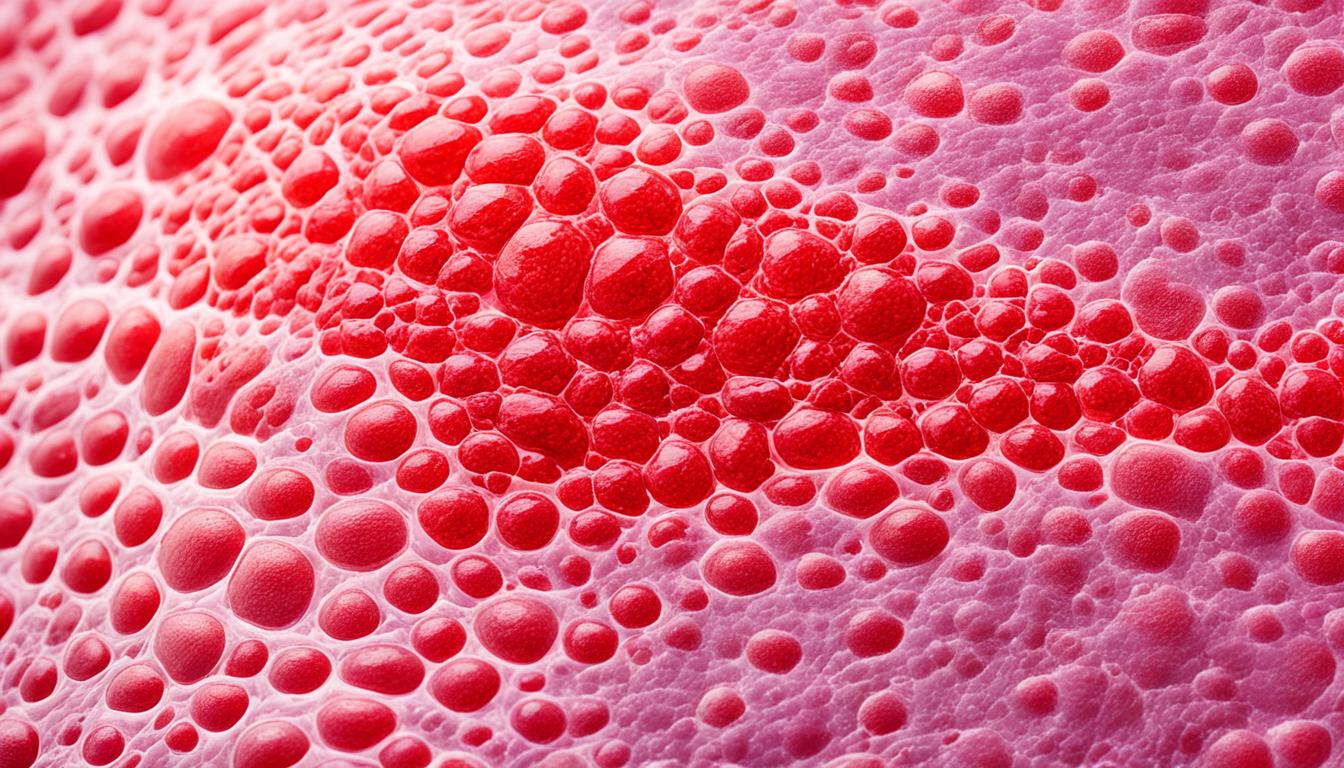Basal cell carcinoma, or cancer basal cell, is a tumor in the skin’s basal cells. These cells make new skin. It looks like a clear bump on areas often in the sun. This includes the face, neck, or arms. Sunlight’s UV radiation is a big reason for this cancer. So, using sunscreen and less time in the sun is important.
Symptoms show as unusual growths or sores that don’t heal. See a skin doctor promptly if your skin looks odd. A quick diagnosis and care are important.
Diagnosing often needs a skin biopsy. This means taking a small skin piece to look at under a microscope. It tells if the cells are cancerous and how far the disease spread.
The treatment plan depends on the cancer’s size, place, and how advanced it is. It can involve surgery, radiation, or applying creams on the skin. These help in varied ways to manage the disease.
Stem cell therapy is becoming a new hope for treating this cancer. Stem cells can turn into different body cells. This might help treat basal cell carcinoma. Studies and tests are looking at how safe and effective this treatment could be.
Key Takeaways:
- Basal cell carcinoma is a type of skin cancer that starts in the basal cells.
- Too much sunlight can greatly increase your risk of developing it.
- Watch out for any strange growths or sores that do not heal.
- For diagnosis, a skin biopsy is often needed to check under a microscope.
- There are various treatments available, from surgery to topical creams.
- Stem cell therapy is a hopeful option for some cases of this cancer.
Symptoms and Diagnosis of Basal Cell Carcinoma
Basal cell carcinoma is a common skin cancer. It mainly occurs on parts of the body that get a lot of sun. This often includes the head and neck. Knowing its symptoms and how it’s diagnosed is key. This can lead to catching it early and getting the right treatment.
This cancer often shows up as unusual skin spots or growths. They can look different from person to person. Here are some examples:
- A shiny, skin-colored bump that is translucent
- A brown, black, or blue lesion with a raised border
- Flat, scaly patches with raised edges
- White, waxy scar-like lesions
If you spot any new growths or sores on your skin, don’t delay seeing a doctor. They will check you over carefully. This includes looking at your medical history. These steps help figure out if you might have basal cell carcinoma.
The usual way to diagnose this cancer is with a skin biopsy. This involves taking a small piece of affected skin for close inspection under a microscope. It’s key for confirming if cancer cells are present. It also shows details about the cancer, like how it’s growing.
In a skin biopsy, a bit of the problem area is taken out. Then, a pathologist studies it. These experts can tell if it’s cancerous. This step gives the final say on a diagnosis.
Getting a skin biopsy is straightforward and doesn’t usually cause much pain. It’s often done in a doctor’s office with a numbing shot. Once confirmed, doctors can plan the best way to treat your cancer.
For basal cell carcinoma, early finding and treatment are crucial. Keep an eye on your skin and make regular visits to a skin doctor. If anything suspicious pops up, you’ll be ready to act fast.
Causes and Risk Factors of Basal Cell Carcinoma
Basal cell carcinoma is mostly caused by too much time in the sun. The sun’s UV rays damage our skin over many years. This can lead to skin cancer.
People with fair skin and light eyes are more at risk. They have less natural protection from the sun. So, they can get hurt by the sun more easily.
As we get older, our skin can’t repair as well from sun damage. That’s why older people can get basal cell carcinoma more often.
If someone in your family had skin cancer, you might be at risk. Keep an eye out and try to stay safe in the sun.
Some diseases can also make you more likely to get skin cancer. These include Gorlin syndrome and xeroderma pigmentosum.
There are other things that could up your risk too. Treating other cancers with radiation can affect your skin in the long run. Medicines that lower your immunity might increase risk. Also, being exposed to arsenic could make you more likely to get basal cell carcinoma.
To lower your chances of getting basal cell carcinoma, protect yourself from the sun. Use sunscreen, wear protective clothes, and avoid the sun at its strongest. Don’t forget to check your skin often. Catching any issues early is key to quick treatment.
Risk Factors for Basal Cell Carcinoma
Promising Stem Cell Therapy for Basal Cell Carcinoma
Stem cell therapy is a new way to treat cancer, especially basal cell carcinoma. It uses the power of stem cells. These cells can change into different kinds of cells. They aim to find and kill cancer cells in the body.
In research and development, this therapy has shown good results for basal cell carcinoma. It can be more accurate and effective than traditional methods like surgery or radiation. And it may cause fewer side effects.
But, more research and trials are needed to know for sure if this therapy is safe and works well. Scientists are working hard to understand how stem cells can help fight cancer. And this brings hope to those with basal cell carcinoma.

